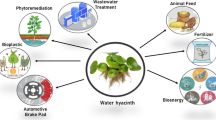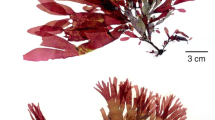Abstract
The main objective of this research was to evaluate the behavior of an ATS system, analyzing the microalgae taxa and biomass produced under different concentrations of nutrients. A fertilizer solution containing NPK (nitrogen, phosphorus, and potassium) in the concentrations of 1, 2, 3, 4, and 5 g L−1 was used. The highest biomass productivity, 13.3 ± 2.5 g m−2 days−1, was found using 5 g L−1 of NPK. The maximum lipid content found was 9.6 ± 1.4% (w/w) and, among the fatty acids identified, palmitic acid is found in greater abundance (35.1 ± 9.4%). The productivity potential of the oil was estimated at 2,865 L ha−1 year−1. The carbohydrate concentration was 23.0 ± 2.5% (w/w) and no statistical differences (p > 0.05) were observed between the fatty acids composition and the carbohydrate content between the samples. The productivity of the periphyton showed a positive correlation with the concentration of nutrients that enter the system. In contrast, the concentration of carbohydrates found in the biomass remained stable at all of the nutrient rates studied. The microalgae evaluation identified that most of the taxa found belong to the class Bacillariophyceae (diatoms).








Similar content being viewed by others
Data availability
All data generated or analyzed during this study are included in this published article.
References
Adey WH, Loveland K (2011) Dynamic aquaria: building living ecosystems. Elsevier, Amsterdam
Adey WH, Kangas PC, Mulbry W (2011) Algal turf scrubbing: cleaning surface waters with solar energy while producing a biofuel. Bioscience 61(6):434–441. https://doi.org/10.1525/bio.2011.61.6.5
Adey WH, Laughinghouse HD IV, Miller JB, Hayek LAC, Thompson JG, Bertman S, Puvanendran SJ (2013) Algal turf scrubber (ATS) floways on the Great Wicomico River, Chesapeake Bay: productivity, algal community structure, substrate and chemistry. J Phycol 49(3):489–501
Adey W (2008) Algal turf scrubbers: cleaning water while capturing solar energy
Allen J, Unlu S, Demirel Y, Black P, Riekhof W (2018) Integration of biology, ecology and engineering for sustainable algal-based biofuel and bioproduct biorefinery. Bioresour Bioprocess 5(1):47
APHA (2018) 2320 ALKALINITY. Standard methods for the examination of water and wastewater. American Public Health Association, New York
Becker FG, Ramos RA, de Azevedo Moura L (2007) Biodiversidade: regiões da Lagoa do Casamento e dos Butiazais de Tapes, planície costeira do Rio Grande do Sul. Ministério do Meio Ambiente Brazil, Brasília
Bohutskyi P, Chow S, Ketter B, Shek CF, Yacar D, Tang Y et al (2016) Phytoremediation of agriculture runoff by filamentous algae poly-culture for biomethane production, and nutrient recovery for secondary cultivation of lipid generating microalgae. Bioresour Technol 222:294–308
Boyd CE, Tucker CS, Somridhivej B (2016) Alkalinity and hardness: critical but elusive concepts in aquaculture. J World Aquaculture Soc 47(1):6–41
Carmo CAFdS, de Araujo WS, Bernardi ACdC, Saldanha MFC (2000) Métodos de análise de tecidos vegetais utilizados na Embrapa Solos. Embrapa Solos-Circular Técnica (INFOTECA-E)
Castillejo P, Chamorro S, Paz L, Heinrich C, Carrillo I, Salazar JG, Lobo EA (2018) Response of epilithic diatom communities to environmental gradients along an Ecuadorian Andean River. CR Biol 341(4):256–263
Christenson L, Sims R (2011) Production and harvesting of microalgae for wastewater treatment, biofuels, and bioproducts. Biotechnol Adv 29(6):686–702
Craggs RL (2001) Wastewater treatment by algal turf scrubbing. Water Sci Technol 44(11–12):427–433. https://doi.org/10.2166/wst.2001.0862
D’Aiuto PE, Patt JM, Albano JP, Shatters RG, Evens TJ (2015) Algal turf scrubbers: periphyton production and nutrient recovery on a South Florida citrus farm. Ecol Eng 75:404–412
Davis R, Kinchin C, Markham J, Tan E, Laurens L, Sexton D, et al. (2014) Process design and economics for the conversion of algal biomass to biofuels: algal biomass fractionation to lipid-and carbohydrate-derived fuel products. Retrieved from
Freitas NCW, Heinrich CG, Etges T, de Souza Celente G, Lobo EA (2021) Assessment of potential reference sites for evaluating the ecological status of subtropical and temperate Brazilian lotic systems using the epilithic diatom community. Environ Sci Pollut Res 28(7):8698–8708
Geider RJ, La Roche J (2002) Redfield revisited: variability of C [ratio] N [ratio] P in marine microalgae and its biochemical basis. Eur J Phycol 37(1):1–17
Hu Q, Sommerfeld M, Jarvis E, Ghirardi M, Posewitz M, Seibert M, Darzins A (2008) Microalgal triacylglycerols as feedstocks for biofuel production: perspectives and advances. Plant J 54(4):621–639
Jerney J, Mayr M, Schagerl M (2016) Biofilm scrubbing for restoration—algae community composition and succession in artificial streams. AIMS Environ Sci 3:560–581
Johnson MB, Wen Z (2010) Development of an attached microalgal growth system for biofuel production. Appl Microbiol Biotechnol 85(3):525–534
Kadir WNA, Lam MK, Uemura Y, Lim JW, Lee KT (2018) Harvesting and pre-treatment of microalgae cultivated in wastewater for biodiesel production: a review. Energy Convers Manage 171:1416–1429
Kesaano M, Sims RC (2014) Algal biofilm based technology for wastewater treatment. Algal Res 5:231–240
Kesaano M, Gardner RD, Moll K, Lauchnor E, Gerlach R, Peyton BM, Sims RC (2015) Dissolved inorganic carbon enhanced growth, nutrient uptake, and lipid accumulation in wastewater grown microalgal biofilms. Bioresour Technol 180:7–15
Kumar D, Singh B (2019) Algal biorefinery: an integrated approach for sustainable biodiesel production. Biomass Bioenerg 131:105398
Le Moal M, Gascuel-Odoux C, Ménesguen A, Souchon Y, Étrillard C, Levain A et al (2019) Eutrophication: a new wine in an old bottle? Sci Total Environ 651:1–11
Leong YK, Huang C-Y, Chang J-S (2021) Pollution prevention and waste phycoremediation by algal-based wastewater treatment technologies: The applications of high-rate algal ponds (HRAPs) and algal turf scrubber (ATS). J Environ Manage 296:113193
Lewis WM Jr, Wurtsbaugh WA, Paerl HW (2011) Rationale for control of anthropogenic nitrogen and phosphorus to reduce eutrophication of inland waters. Environ Sci Technol 45(24):10300–10305
Liu N, Yang Y, Li F, Ge F, Kuang Y (2016) Importance of controlling pH-depended dissolved inorganic carbon to prevent algal bloom outbreaks. Bioresour Technol 220:246–252
Liu J, Pemberton B, Lewis J, Scales PJ, Martin GJO (2019) Wastewater treatment using filamentous algae—a review. Bioresour Technol 122556
Lobo EA, Schuch M, Heinrich CG, Da Costa AB, Düpont A, Wetzel CE, Ector L (2015) Development of the Trophic Water Quality Index (TWQI) for subtropical temperate Brazilian lotic systems. Environ Monit Assess 187(6):1–13
Lobo EA, Heinrich CG, Schuch M, Wetzel CE, Ector L (2016) Diatoms as bioindicators in rivers. River algae. Springer, New York, pp 245–271
Lobo EA, Wetzel CE, Schuch M, Ector L (2014) Diatomáceas epilíticas como indicadores da qualidade da água em sistemas lóticos subtropicais e temperados brasileiros. EDUNISC, Santa Cruz do Sul
Lobo EA (2016) Índice trófico de qualidade da água: guia ilustrado para sistemas lóticos subtropicais e temperados brasileiros
Marella TK, Datta A, Patil MD, Dixit S, Tiwari A (2019) Biodiesel production through algal cultivation in urban wastewater using algal floway. Bioresour Technol 280:222–228
Martini FA, Rubert A, de Souza MP, Kist LT, Hoeltz M, Benitez LB et al (2019) Periphytic biomass composition and exploitation from algae turf scrubber system. SN Appl Sci 1(7):765
Metzeltin D (2007) Tropical diatoms of South America II. Special remarks on biogeographic disjunction. Iconogr Diatomol 18:1–877
Metzeltin D, Lange-Bertalot H, Gacía-Rodoríguez F (2005) Diatoms of Uruguay compared with other taxa from South America and elsewhere. Iconographia Diatomologica 15:736
Mulbry W, Kondrad S, Buyer J (2008a) Treatment of dairy and swine manure effluents using freshwater algae: fatty acid content and composition of algal biomass at different manure loading rates. J Appl Phycol 20(6):1079–1085
Mulbry W, Kondrad S, Pizarro C, Kebede-Westhead E (2008b) Treatment of dairy manure effluent using freshwater algae: algal productivity and recovery of manure nutrients using pilot-scale algal turf scrubbers. Bioresour Technol 99(17):8137–8142
Ortiz-Tena JG, Rühmann B, Schieder D, Sieber V (2016) Revealing the diversity of algal monosaccharides: Fast carbohydrate fingerprinting of microalgae using crude biomass and showcasing sugar distribution in Chlorella vulgaris by biomass fractionation. Algal Res 17:227–235
Pittman JK, Dean AP, Osundeko O (2011) The potential of sustainable algal biofuel production using wastewater resources. Bioresour Technol 102(1):17–25
Remmers IM, Wijffels RH, Barbosa MJ, Lamers PP (2018) Can we approach theoretical lipid yields in microalgae? Trends Biotechnol 36(3):265–276
Salinas-Camarillo VH, Carmona-Jiménez J, Lobo EA (2021) Development of the Diatom Ecological Quality Index (DEQI) for peri-urban mountain streams in the Basin of Mexico. Environ Sci Pollut Res 28(12):14555–14575
Sant’Anna CL (2006) Manual ilustrado para identificação e contagem de cianobactérias planctônicas de águas continentais brasileiras: Interciência. Sociedade Brasileira de Ficologia, São Paulo
Schnurr PJ, Allen DG (2015) Factors affecting algae biofilm growth and lipid production: a review. Renew Sustain Energy Rev 52:418–429
Shuba ES, Kifle D (2018) Microalgae to biofuels: ‘Promising’ alternative and renewable energy, review. Renew Sustain Energy Rev 81:743–755
Sindelar HR, Yap JN, Boyer TH, Brown MT (2015) Algae scrubbers for phosphorus removal in impaired waters. Ecol Eng 85:144–158
Siville B, Boeing WJ (2020) Optimization of algal turf scrubber (ATS) technology through targeted harvest rate. Bioresour Technol Rep 9:100360
Sluiter JB, Ruiz RO, Scarlata CJ, Sluiter AD, Templeton DW (2010) Compositional analysis of lignocellulosic feedstocks. 1. Review and description of methods. J Agric Food Chem 58(16):9043–9053
USEPA (2007) Method 3051A microwave assisted acid digestion of sediments, sludges, soils, and oils. Z Für Anal Chem 111:362–366
Vymazal J (2014) Constructed wetlands for treatment of industrial wastewaters: a review. Ecol Eng 73:724–751
Waghmare A, Patil S, LeBlanc JG, Sonawane S, Arya SS (2018) Comparative assessment of algal oil with other vegetable oils for deep frying. Algal Res 31:99–106
Weyer KM, Bush DR, Darzins A, Willson BD (2010) Theoretical maximum algal oil production. Bioenergy Res 3(2):204–213
Wurtsbaugh WA, Paerl HW, Dodds WK (2019) Nutrients, eutrophication and harmful algal blooms along the freshwater to marine continuum. Wiley Interdiscip Rev Water 6(5):e1373
York PV, Johnson LR (2002) The freshwater algal flora of the British Isles: an identification guide to freshwater and terrestrial algae. Cambridge University Press, Cambridge
Yun J-H, Cho D-H, Lee S, Heo J, Tran Q-G, Chang YK, Kim H-S (2018) Hybrid operation of photobioreactor and wastewater-fed open raceway ponds enhances the dominance of target algal species and algal biomass production. Algal Res 29:319–329
Zhu C, Chen S, Ji Y, Schwaneberg U, Chi Z (2021) Progress toward a bicarbonate-based microalgae production system. Trends Biotechnol 40:180–193
Acknowledgements
This study was financed in part by the Coordenação de Aperfeiçoamento de Pessoal de Nível Superior—Brasil (CAPES)—Finance Code 001 and by the Conselho Nacional de Desenvolvimento Científico e Tecnológico—Brasil (CNPq) under Grant number 439323/2018-5 and number 310228/2019-0.
Author information
Authors and Affiliations
Corresponding author
Ethics declarations
Conflict of interest
On behalf of all authors, the corresponding author states that there is no conflict of interest.
Additional information
Publisher's Note
Springer Nature remains neutral with regard to jurisdictional claims in published maps and institutional affiliations.
Rights and permissions
Springer Nature or its licensor (e.g. a society or other partner) holds exclusive rights to this article under a publishing agreement with the author(s) or other rightsholder(s); author self-archiving of the accepted manuscript version of this article is solely governed by the terms of such publishing agreement and applicable law.
About this article
Cite this article
da Silva Szarblewski, M., Alves, G., Heinrich, C.G. et al. Evaluation of the composition and identification of periphytic microalgae biomass in the algal turf scrubber system under different concentrations of nutrients. Sustain. Water Resour. Manag. 9, 90 (2023). https://doi.org/10.1007/s40899-023-00873-8
Received:
Accepted:
Published:
DOI: https://doi.org/10.1007/s40899-023-00873-8




